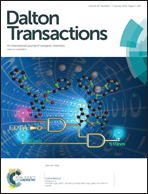Organometallic turnstiles: acid and base locking and unlocking†
Abstract
A symmetrical organometallic Pt(II) based molecular turnstile 1, composed of a rotor bearing two benzonitrile units as coordinating sites and a stator equipped with a dianionic tridentate coordinating pole, undergoes a reversible switching process between two open and one closed states. In the absence of an effector, the turnstile is in its open state defined by the free rotation of the rotor around the stator. In the presence of Pd(II), the latter is simultaneously complexed by both the rotor and the stator (1-Pd) leading to the first closed state owing to locking of the rotational movement. The turnstile can be unlocked to its second open state 1-Pd-DMAP by addition of para-dimethylaminopyridine (DMAP) behaving as an external competitive ligand replacing the bound benzonitrile in the coordination sphere of the Pd centre. Upon addition of PdCl2(CH3CN)2, a competitive metal complex to remove DMAP, the turnstile is switched back to its closed state. The same process can also be achieved upon addition of MsOH causing the protonation of DMAP into DMAP-H+ and its decomplexation and replacement by one of the two benzonitrile groups of the rotor. Finally, the deprotonation of DMAP-H+ by addition of Et3N as a base regenerates the second open state of the turnstile.


 Please wait while we load your content...
Please wait while we load your content...